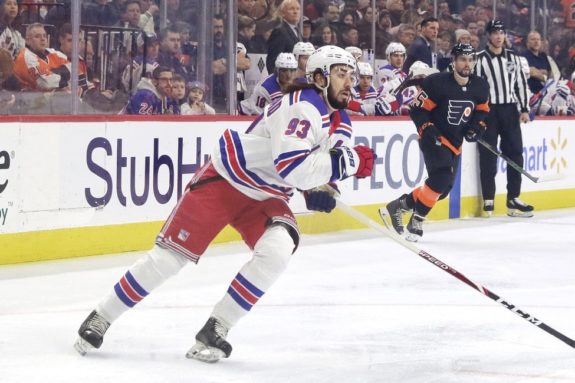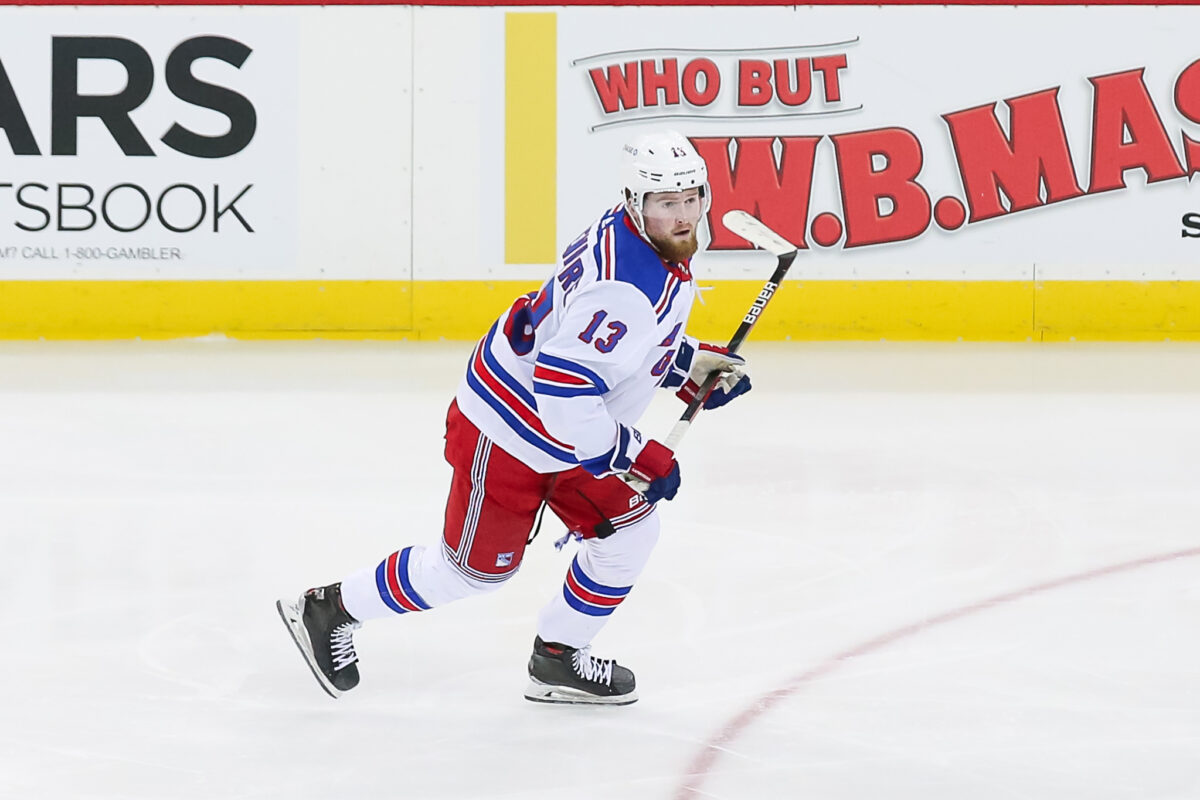There’s a caveat generally employed around the NHL when it comes to line construction, and it tends to be a sound one – avoid stocking your No. 1 unit top with your three best forwards. The intention is to prevent teams from suffering a major pitfall: Becoming too easy to defend.
If a loaded top line gets shut down or struggles, the thinking goes, the resulting thinned out-depth up front becomes a big problem if those theoretically less talented second and third lines can’t fill the offensive gap.
At least two teams, however, have rejected such accepted wisdom to extremely positive results. If creating a “Super Line” isn’t yet a full-on trend, it’s been proven to work in certain situations, thus begging the question: Should the New York Rangers give it a whirl?

More specifically: Should the Blueshirts reunite Artemi Panarin and Mika Zibanejad – their two established elite offensive forwards – after a brief partnership to start the 2019-20 season and add perhaps high-end youngsters Alexis Lafreniere or Kaapo Kakko to round out the trio?
Why even consider this? Because it’s difficult to ignore what the Colorado Avalanche and Boston Bruins have gained by discarding the “dogma” about the supposed dangers of a top-heavy top line, instead of benefiting from steamroller No. 1 forward units that give their respective rosters much of their identity – and have led to plenty of victories.
Avalanche, Bruins Roll by Uniting Their Three Best Forwards
The high-speed Avs are driven by the engine of Mikko Rantanen, Nathan MacKinnon and Gabriel Landeskog, a unit that produced 183 points in 154 games this season, with those three players finishing 1-2-3 in scoring for Colorado. With size, speed, power and elite skill, the line often resembles a runaway train that has slowly developed into a nearly impossible-to-defend trio since it was first tried during the 2016-17 season.
In 2020-21, the Rantanen-MacKinnon-Landeskog unit posted a 66.2 Corsi for percentage (CF%) and a 66.7 goals for percentage (GF%), generating 116 High Danger Chances For to only 61 against.
“Being Nate’s wingman … it’s definitely one of the best jobs in hockey,” Landeskog, in his ninth season as team captain, said of the Avs’ superlative No. 1 center. “It’s been fun to getting to know these two guys over the last few years as players and obviously as people. Hopefully, we can continue to get better and better as we go on.”

A popular preseason pick to win the Stanley Cup, Colorado again failed to break through this season, falling in six games in the second round to the Vegas Golden Knights. The Avs’ top line, however, delivered 41 points in the club’s 10 playoff games.
Colorado recorded 90 or more points for three straight seasons from 2017-20, including the COVID-shortened 2019-20 season, and tied for the most points in the NHL this season with 82.
The results have been largely the same in Boston, where the “Perfection Line” of Brad Marchand, Patrice Bergeron and David Pastrnak has been a dominant group since 2014-15 when they first started spending time on the same forward unit. In 2020-21, they posted a 65.7 CF% and a 64.0 GF% while generating 85 high danger chances for and 48 against.
The line became a long-term fixture in 2016-17. Starting with that season, the Perfection Line hasn’t finished with a CF% lower than 56 and has exceeded 60 percent twice. It’s led to some gaudy individual numbers: Marchand recorded 100 points in 2018-19 and has averaged 1.2 points per game since 2016-17. Pastrnak totaled 48 goals and 47 assists – both career highs – in 70 games last season, while Bergeron recorded three straight 30-goal seasons (2017-18 through 2019-20) for the first time in his 17-year career.

So much for making it easy for opponents to defend you by overloading the No. 1 line.
“They’re … going to get chances, they’re three great players on a line, they’re dangerous, they’re smart, they’re elusive, they can shoot the puck, and they’re ultra-competitive,” said Islanders coach Barry Trotz, whose team limited the Bruins’ top trio enough to defeat them in the second round of the playoffs. (From ‘Islanders’ Task Still The Same: Containing Bruins’ Perfection Line,’ New York Post, 6/1/21)
The Bruins were certainly successful before teaming Marchand, Pastrnak and Bergeron, as they’ve been a perennial championship contender for much of the 21st century. However, they’ve put together three straight 100-point seasons for the first time since the late 1970s and reached a Stanley Cup Final since the Perfection Line came into existence.
Panarin, Zibanejad Have Spent Little Time on Same Line
There’s no guarantee this will work for the Rangers, of course. Though the sample size was smaller, just 233:01 time on ice together at 5-on-5 in 2019-20, Panarin and Zibanejad didn’t make magic as linemates. They posted a 51.1 CF%, but an xGF% of only 45.5 while getting out-high danger chanced 38-54.
Plus, it’s hard to argue with Panarin’s results since his arrival as a free agent in the summer of 2019 – and it might not be something the Rangers want to jeopardize with a major change. With Ryan Strome as his center, Panarin established a career-high with 95 points in just 69 games in 2019-20, and his 58 points in 42 games this past season represented a career-best 1.38 PPG.
There’s also a concern with the style of play. Both Panarin and Zibanejad like to set up at the left circle to fire their heavy shots in the offensive zone, meaning at least one of them would be forced to adapt and adjust. However, it’s worth noting that both players operate on the Rangers’ top power-play unit, with the Blueshirts finishing over 20% with the man advantage each of the last two seasons, including 22.9 in 2019-20 that was good for seventh overall.
With Zibanejad excelling on one line – he averaged a point per game over the 2018-19 and 2019-20 seasons – and Panarin powering another, a case can be made that the Blueshirts send out two potentially elite units. The Chicago Blackhawks stand as the most recent argument for breaking up your superstars, winning three Stanley Cups since 2010 with Patrick Kane and Jonathan Toews playing mostly on separate lines.
The Avs and Bruins, though, have clearly illustrated that there’s another way to deploy your best forwards – to great effect.
Would more time together for Panarin and Zibanejad, along with the right linemate, catapult their games into the stratosphere, the way it’s done for Marchand, Pastrnak, MacKinnon, Rantanen, etc.? Would 50-goal seasons be in reach for Zibanejad, who scored 41 in only 57 games in 2019-20? Would Panarin’s slick passing to a finisher like Zibanejad and perhaps Lafreniere or Kakko result in him consistently hitting the 100-point mark?
The only way to find out is to try.

Such an arrangement only succeeds, of course, if a team can come up with adequate depth behind a super line. The Bruins had to trade for Buffalo Sabres forward Taylor Hall at the deadline when it became apparent that they lacked enough scoring behind their dominant top forward unit. The Avalanche added forwards Andre Burakovsky prior to the 2019-20 season and Brandon Saad before this past season to bolster the offense behind their Big Three.
A Super Line Might Prove to Be Better Configuration for Rangers’ Roster
Barring a big trade for a center, it’s possible the Rangers, flush with young talent from their three-year-old rebuilding project, might well have the personnel to fill in behind a Panarin-Zibanejad-led top line. Vitali Kravtsov looked the part of a future offensive force late last season, albeit in limited duty. Should Lafreniere, who made major strides as last season wore on, not draw the assignment on Zibanejad’s other flank, the Blueshirts would have the top overall draft pick in 2020 on their second line. There’s also Chris Kreider and Pavel Buchnevich as options on a second unit.
Also, by concentrating more of their top offensive talents on the first and second line, rather than spreading them throughout the lineup, the Rangers might be better positioned to remake the bottom two lines in a grittier, tougher image – a priority for new general manager Chris Drury this offseason. If the club is determined to keep left wings Panarin, Kreider and Lafreniere and right wings Buchnevich, Kakko and Kravtsov on separate lines, there will be fewer spots available to bulk up the forward corps – unless, of course, some of those players are traded in the process.

The experiment of creating a loaded first line would be a daring one. It would mean potentially exposing Strome as a player whose big numbers the past two seasons were due significantly to his partnership with Panarin – and exacerbating the Blueshirts’ considerable depth issues at center in the process. It could be a total bust, with the games of the two star forwards proving to be incompatible and forcing new coach Gerard Gallant into a major early decision on whether to separate them quickly or give them more time to mesh – a situation that could hang over the team.
Still … what if it works, and the Rangers end up with a No. 1 forward unit that’s all but unstoppable on a nightly basis – perhaps approaching, if not exactly rivaling, the situations in Colorado and Boston? It would certainly be exciting for fans. And it might help accomplish just what owner James Dolan mandated when he dismissed team president John Davidson and general manager Jeff Gorton last month – moving the Rangers past the rebuilding period and into the next phase of consistent playoff contention.
Advanced statistics courtesy of naturalstattrick.com.